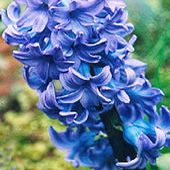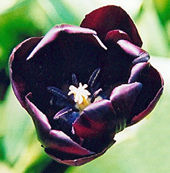Wednesday 11 April 2007
Perfect green
Every year it amazes me, though really perhaps I should be used to it by now, this sudden greening over of everything, starting just now in the garden and in the gardens around, and in the streets I walk down, where the chestnut tree leaves come out.
In the garden, the blackbirds have already had one brood, probably because of the mild weather, and two juvenile blackbirds follow the adults around the garden, demanding feeding. While the female blackbird starts a second nest, carrying in to the ivy on the wall huge beakfuls of the grasses and mosses and foliage she has gathered. Her nesting activity is energetic and vigorous and committed, and the gardener sitting nearby, having a rest and a cup of tea, feels quite lazy by comparison.
The akebia quinata is all fluttering new green, with tiny purple flowers between that seem dull purple until the light catches them in the morning and then they're all glowing.
Yesterday was my sister's birthday - always thought of, even though she's gone. I've lost track now of how old she would have been this year - 40-something. It doesn't matter. 61 years ago on the 9 April my grandmother died of the same disease that killed my sister. This time of the year when the buds are bursting I think about both of them even more than usual, and how important it is just to see another season, another spring.
Rampant overgrown climbers
Several plants had grown rather too big for the garden, and radical action was needed this spring.
I had a problem with overgrown climbers - several of them. The rose Madame Alfred Carriere, which has long been established on the house wall, blew off the wall sometime last year, and much of it was resting on the shed roof. I attempted to prune it in a moderate fashion, planning to reattach it to the wall, but had to admit defeat, and ended up having to saw off one huge branch entirely. The rest I managed to salvage and reattach to the trellis archway around the corner, though this was no easy task, the stems being several metres long.
Then there was the golden hop. A lovely thing, and it has carried on in its loveliness for many years, getting thicker in stem and sending out roots the thickness of a hosepipe - as I discovered when I decided to dig it up. I wanted to do this last spring, but settled for radical cutting back. From its vast girth it had thrown up new stems all the stronger. It had outgrown the place it was in, and in that particular place against the boundary wall I've long known I needed something a little more compact, and evergreen, because in the winter when the hop dies back there's not enough screening from the street. And in the summer, we spend far too long cutting back the hop to stop it being a nuisance.
So it's gone. But I did keep a couple of rooted pieces, which are in a pot at the moment, while I decide if there's another place in the garden where a golden hop could grow in its fabulously rampant way without having to be cut back every five minutes.
And when I say it's gone - I think that it was so well-established and with so many bits of it sneaking across the flowerbed that I may find it's still there, emerging in the middle of the dahlias nearby, or even right across the other side of the garden.
Over on the other side of the garden, was that pyracantha I mentioned once before, growing in a north-east facing corner against the outhouse. Another plant in the wrong place, as it never flowered (and therefore had no berries) apart from the part at the top that was in the sun. How much more sensible it would be, I thought, if the pyracantha was over the other side, in the sun, where the hop was, it being an evergreen, and just right for the gap. And with us needing to get some work done on the shed roof, with a thorny pyracantha in the way.
But could you move a large, well-established pyracantha? I thought I'd have a go, or I'd never know. I realised that I'd have to prepare the planting hole in advance, and dash across with the uprooted pyracantha, hoping that if I was quick enough it would never notice it had been rudely dug up and relocated. It had a huge rootball and I had to drag it across to its new location on a plastic sheet, unable to lift its great weight.
It's okay at the moment - looks still alive, though not actively growing, and probably sulking. But it is absolutely perfect for the gap where the golden hop used to be. So perfect that I felt quite smug when I spread out the branches in the new location and they fanned out just right in the gap.
And then there was the Parthenocissus quinquefolia - the Virginia creeper - planted about eight years ago in the corner near the kitchen, next to the pyracantha I mentioned above. Quite close to the drain from the kitchen sink. The thing is, it's a Victorian house, with a history of subsidence, and the drains are old and probably cracked, and planting a rampant climber right next to them was probably a bad idea. And it is beautiful in autumn when the leaves turn colour, but it's not so great when it lifts the tiles from the shed roof with its creeping tendrils, and blocks all the light from the house windows. So it went too. Another plant that took a lot of hard work to remove, with roots that went down so far they probably met my email friends in the other hemisphere.
The area near the kitchen drain is now clear of plants, and should probably never have had any in it in the first place. Like many people, I liked the idea of covering the house walls with plants. But picked the wrong ones, and put them in the wrong place. I've rather gone off the idea of growing things up the house walls. I think I'd rather look out on my climbers, rather than trying to peer through them.
Busy bees, busy birds, and busy me
I've been so busy in the garden and there's so much to report that I've had to split it into more than one posting today, when I've finally had chance to reflect on recent gardening.
There's been a general overhaul of the garden this spring, and I had to be ruthless and unsentimental, in order to reclaim some space. Quite a lot of vegetation has gone on the compost heap, or to the green waste recycling facility at the local tip.
The garden was getting on my nerves a little, but I wasn't sure why, until I looked at it very critically and realised that there were a fair number of plants that were more trouble than they were worth, were in the wrong place, or that I just didn't like very much. So I've been very busy out there, and now, for the first time in years, there are actually empty spaces and blank bits of house wall, free of climbers.
When I started gardening here I seem to have collected a lot of plants and planted them without really knowing what I was doing. Some have worked out and flourished, and others haven't. A lot of things seem to have disappeared, probably because there was too much in there. Certain things - like some hardy geraniums, and the Arum italicum, seem to have done too well, and there were bits of them everywhere, far more than I wanted. Then there were the bits of things in pots that I'd intended to give away and never had. (And then found that most people I knew had them already and didn't want any more, as they'd grown too well in their gardens too.)
So, hard as it was, in order to feel like this was a garden and not a place for any old random plant to grow, I had to get tough. I've had a horrible cold just recently and was in a bad mood about it, so it was easier to think "Sod it, this is all going on the compost heap!".
The more exciting stage, after the clearing out, was to think about what plants I really like, and wanted, and to find some funds for them and go out and buy them. Details to follow, when they flower and do their thing.


